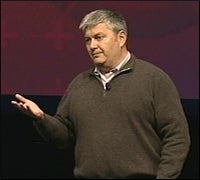 |
| Microsoft’s Jon DeVaan speaks at WinHEC 2008 |
LOS ANGELES, Calif. -– In launching the Windows Hardware Engineering Conference (WinHEC), Microsoft choose to place early emphasis on the problems led to so much grief for the launch of Windows Vista.
Show attendees (far fewer than the hordes at last week’s Professional Develop Conference) are also getting free copies of Windows 7 pre-beta code, just like at PDC.
And this show opened with a keynote that was all Windows 7, unlike last week, where Windows 7 was on day two of PDC and only a portion of the keynote.
Jon DeVaan, senior vice president of the Windows Core Operating System division, opened the show, telling the audience that the build they had was “API complete but not UI complete,” so the interface is still a work in progress.
After reusing the joke from last week, that Microsoft heard complaints on Vista from “journalists, bloggers, and some commercials,” DeVaan said Microsoft realized that an ecosystem had to be in place for Windows 7.
“We knew we had to give reliable early builds, builds that would give confidence that when we say we’re going to ship Windows on a particular date, you’ll believe us,” he told the gathering here.
One of the major problems with Vista was it was delayed so often that when Microsoft set its November 2006 completion date, many vendors didn’t believe the company, and dragged their feet. When it became clear Microsoft would keep that date, OEMs had to scramble to get drivers out, and many were subpar.
He did a few performance demos, one showing how Windows 7 doesn’t lose performance as more windows are opened, while Vista’s performance degrades. He also demonstrated a new API called Direct2D, where graphics acceleration on the desktop could be sped up by a factor of four or five thanks to using the GPU in the system.
There was also considerable talk on power consumption, especially for laptops. A command line utility called powercfg allowed for monitoring how each component is used in a system, perfect for the hardware developers at this show, and he showed how DVD playback on identical hardware consumed much less power on Windows 7 vs. Vista.
The issue of 64-bit support was brought up as well, but again, only briefly. Microsoft noted that in October of this year, 20 percent of the new computers coming to Windows Update were running 64-bit Vista. In August it was 10 percent, so 64-bit is ramping up fast. Beyond that, though, there wasn’t much talk about 64-bit drivers, although there are sessions at the show to discuss 64-bit conversions.
What is Steve Jobs doing here?
At that point, DeVaan was joined on stage by Steven Sinofsky, the senior vice president in charge of the Windows development team. Dressed in a black sweater and blue jeans, Sinofsky bore a rather notable resemblance to Apple CEO Steve Jobs, albeit with less hair and more body weight.
The two discussed the issues around Device Smart, the major revision of Windows 7’s ability to discover and manage attached devices. “In Vista, there were lots of places where you would go to discover a device,” he noted. A multifunction device would show up as both a printer and scanner, which would be scattered around the device listing. Multiple media device reader would appear as nine separate drives rather than one.
Windows 7 has a new view called Devices and Printers that shows image of the device and computer connected to it. Each device has a larger, more detailed image that is a replica of the device. Even USB drives had a separate, unique look, so you could know which one you were removing from the computer.
Devices can now add some XML metadata, so that when they are installed, data is pulled down from the Internet, such as driver info and all of the information on the device, such as a performance and status monitor.
Microsoft is making a concerted effort to improve the ability to install and update third-party hardware and making those drivers and support utilities reachable via the Internet, in case an install CD is not readily available. “We know this is one of the key inhibitors in enabling end-to-end support,” he said.
He repeated last week’s demo of a netbook running Windows 7, with more detail this time. It was an ASUS Eee-PC with 1GB of memory, a 16GB solid state drive and a dual core Atom processor running at 1.6GHz. Windows 7 ran fully, not stripped down, with all of its services running.
Tomorrow’s keynote will highlight Windows Server 2008 R2, which is due for release next year.


